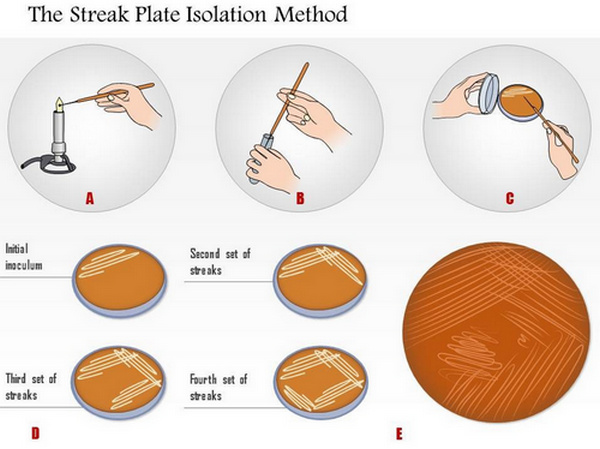Bacterial culture is employed:
1. To isolate bacteria in pure culture.
2. To demonstrate their properties.
3. To obtain sufficient growth for antigen preparation.
4. For typing of microorganisms.
5. To determine antibiotic sensitivity.
METHODS OF BACTERIAL CULTURE:
STREAK CULTURE
- The medium in a petridish may be inoculated by loop, swab or other suitable device. Once the primary inoculum is made, a loop or straight wire can be used for spreading the material into four quadrants of the plate.
- A platinum or nichrome wire loop of 2-4 mm diameter with 2 to 3 inches long wire is first sterilized in the Bunsen flame and cooled by touching an uninoculated part of the medium. Then a loopful of specimen is gently smeared onto the surface of a well dried plate of medium near the peripheral area.
- The inoculum is then thinly spread in parallel lines in different segments of the plate. The loop is sterilized between different sets of streaks.
- The plate is incubated at 37°C for overnight. Confluent growth occurs at the primary site of inoculation and well separated colonies appear on the final series of streaks.
STROKE CULTURE
- It is done on agar slope for providing a pure growth of bacteria for slide agglutination and other diagnostic tests.
STAB CULTURE
- Stab culture is performed by a 4 inch long thick straight wire, charged with culture material, deep inside the agar.
- This technique is employed to demonstrate gelatine liquefaction, motility, oxygen requirement and maintenance of stock culture.
LAWN/CARPET CULTURE
- This technique is employed in antibiotic sensitivity testing (disc diffusion method) and in bacteriophage typing.
- Specimen of liquid culture or suspension of bacterial emulsion is poured on the surface of a culture plate and kept for a minute and then excess material is thrown out.
- Alternatively, the surface of the plate may be inoculated by a sterile swab soaked in liquid bacterial culture or emulsion.
POUR PLATE CULTURE
- Several tubes containing 15 ml agar medium in each are melted and left to cool in water bath at a temperature of 45-50°C. The inoculum to be tested is diluted in serial dilutions.
- One ml volume of each diluted inoculum is added to each tube of molten agar and mixed well. The content of each tube is poured into separate petridish and allowed to solidify.
- After overnight incubation the plates are examined for bacterial colonies. Colonies will be seen throughout the depth of the medium which are counted by colony counter.
- This technique is employed to estimate viable bacterial count in a suspension. It is also the recommended method for bacterial count in urine cultures.
SWEEP PLATE METHOD
- It is useful in studying microorganisms of a fabric e.g. a table cloth etc.
- The edges of the petri dish containing culture medium are rubbed over the cloth or fabric with the medium facing it.
- The medium is incubated. The dust particles of the cloth settle on the medium forming colonies which can be counted and estimated.
ADVANTAGES OF SOLID CULTURE MEDIA
- There is separate colony formation.
- By studying colonial morphology, presumptive identification of most bacterial species can be made.
- Quantitative bacterial count and relative proportion of different bacterial species can be made.
- Isolation of bacteria in pure culture can be made by picking isolated bacterial colonies and subculturing into fresh medium. This is necessary for full identification of bacteria.
LIQUID CULTURE MEDIA
- These are distributed in test tubes with cotton wool stoppers and screw-capped bottles or flasks.
ADVANTAGES OF LIQUID CULTURE MEDIA
- When bacteria are present in small numbers in the inocula, they will grow only in liquid media e.g. blood culture.
- Specimens containing inhibitory substances like antibiotics and other antibacterial substances get diluted by inoculation into the larger volume of the fluid medium.
- Liquid media are widely used for biochemical tests.
- These are also useful enrichment media like selenite F broth.
- Large inocula can be tested in liquid media, e.g. gauge for sterility test.
- Presumptive bacterial count in water sample is made in liquid media.
DISADVANTAGES OF LIQUID CULTURE MEDIA
- Isolation of bacteria in pure culture is not possible.
- Identification of bacteria is not possible.
INCUBATION OF BACTERIAL CULTURE
AEROBIC BACTERIAL CULTURE
- Most of the pathogenic organisms grow best at 37°C or body heat. The culture media, after inoculation, is incubated at 37°C in an incubator.
- Some bacteria require special temperatures for growth, eg. 45°C for campylobacters and 30°C for leptospires. Extra CO2 is needed for optimal growth of some bacteria, eg. B.abortus.
ANAEROBIC BACTERIAL CULTURE
- Anaerobic bacteria require incubation without oxygen.
- However a few anaerobes are aerotolerant eg. Clostridium histolyticum which may produce some growth on the surface of aerobic plates, while vast majority are strict anaerobes eg. Clostridium tetani.
- Anaerobiosis can be established by various methods.
Various methods of anaerobiosis:
- Displacement of oxygen
- Cultivation in vacuum in a vacuum dessicator
- Displacement of oxygen
- By an inert gas like hydrogen or nitrogen
- By the use of Candle jar
- Absorption of oxygen by chemicals
- Pyrogallic acid
- Mixture of powdered chromium and sulphuric acid
- Gas-pak
- By displacement and combustion of oxygen
- McIntosh and Filde’s anaerobic jar
- By biological methods
- Incubating aerobic and anaerobic organisms together
- By incorporating reducing agents in media
- Thioglycollate broth
- Robertson’s cooked meat medium


